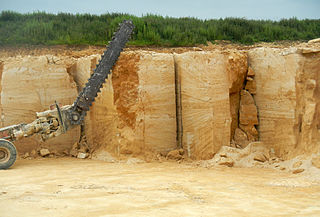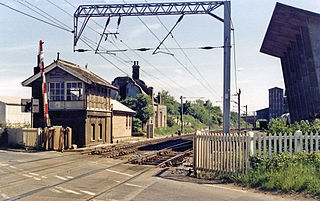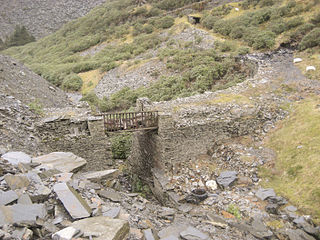Related Research Articles
ARC may refer to:

British Thomson-Houston (BTH) was a British engineering and heavy industrial company, based at Rugby, Warwickshire, England, and founded as a subsidiary of the General Electric Company (GE) of Schenectady, New York, United States. They were known primarily for their electrical systems and steam turbines.
The Potteries, Shrewsbury & North Wales Railway,, was a project to build a line from the Potteries via Market Drayton, Shropshire, to quarries at Nantmawr and Criggion, Wales. It was initially opened in 1866, obtaining notoriety as the most expensive non-metropolitan railway then built, but was never constructed between Shrewsbury and the Potteries. The line rapidly became very run down as a result of low revenues and poor maintenance, and was closed for safety reasons in June 1880, becoming one of the few railways to close in Victorian times. Attempts to re-open the line were made in the late 1880s and the 1890s by the Shropshire Railways, which took over the property, but these failed. After years of lying derelict, it re-opened as the Shropshire & Montgomeryshire Light Railway in 1911.
The Liverpool, St Helens and South Lancashire Railway, was formed in 1889, but no services ran until 1895 and then only freight. Passenger services did not start until 1900. It incorporated the St Helens and Wigan Junction Railway. It was taken over by the Great Central Railway in 1906.

Royal Doulton is an English ceramic and home accessories manufacturer founded in 1815. Operating originally in Vauxhall, London, later moving to Lambeth, in 1882 it opened a factory in Burslem, Stoke-on-Trent, in the centre of English pottery. From the start the backbone of the business was a wide range of utilitarian wares, mostly stonewares, including storage jars, tankards and the like, and later extending to pipes for drains, lavatories and other bathroom ceramics. From 1853 to 1901 its wares were marked Doulton & Co., then from 1901, when a royal warrant was given, Royal Doulton.
The City of Birmingham Tramways Company Ltd operated trams in Birmingham, England, from 1896 until 1911.

The Penlee Quarry railway was a 2 ft narrow-gauge industrial railway serving the Penlee Quarry at Newlyn in Cornwall, England, UK. It was Cornwall's most westerly railway and one of the last operating narrow-gauge industrial railways in the UK.

Doulting is a village and civil parish 1.5 miles (2 km) east of Shepton Mallet, on the A361, in the Mendip district of Somerset, England.
Edgar Allen and Company was a steel maker and engineer, which from the late 19th century was based at Imperial Steel Works, Tinsley, Sheffield, South Yorkshire. The site was bounded by Sheffield Road, Vulcan Road and the Sheffield District Railway to which it was connected.

Hants & Dorset Motor Services was a stage carriage bus service operator in southern England between 1920 and 1983.
The Berrima railway line is a partly closed private railway line in New South Wales, Australia. It was a short branch from the Main South line to serve the Berrima Colliery.
Consolidated Gold Fields was a British gold-mining company. It was listed on the London Stock Exchange and was a constituent of the FTSE 100 Index until it was acquired by Hanson in 1988.

Doulting Stone Quarry is a limestone quarry at Doulting, on the Mendip Hills, Somerset, England.

Claydon railway station was a station in Claydon, Suffolk. It closed to passengers in 1963. The goods facility for Blue Circle Cement, British Steel Piling and Kings Scrapyard was still staffed in the late 1970s with the staff working from the former up side station buildings.

Some industrial narrow-gauge railways in the United Kingdom and the Isle of Man were primarily built to serve quarrying, mining, and similar industries. Some of these narrow-gauge railways offered passenger services for employees or workmen, but they did not run public passenger trains. They are listed by the primary industry they served.
The Alford Valley Railway is a historic railway in Scotland that ran between Alford and Kintore. The company was formed in 1856, the line was opened in 1859, and it was absorbed by the Great North of Scotland Railway in 1866. It was closed to passengers in 1949 and to goods in 1965.

Kentish ragstone is a hard grey limestone in Kent, England, drawn from the geological formation known as the Hythe Beds of the Lower Greensand. For millennia it has been quarried for use both locally and farther afield.
Carnforth MPD is a former London Midland and Scottish Railway railway depot located in the town of Carnforth, Lancashire, England.
George Cohen, Sons and Company was a scrap metal merchant with offices in Commercial Road, London. The company was founded by George Henry Cohen (d.1890) as Messrs. George Cohen & Co. in 1834 and changed its name to George Cohen, Sons and Co. in 1883 on the appointment of Michael Cohen, son of the founder. After the First World War the company won a number of large contracts to dispose of surplus munitions including "400,000 tons of high explosives and other shells". The company also engaged in demolition work, with projects including the towers of Crystal Palace, which had survived the great fire, the Dome of Discovery and Skylon at the Festival of Britain, and London's tram system. In 1940 the company moved its head offices to Hammersmith.

Thos. W. Ward Ltd was a Sheffield, Yorkshire, steel, engineering and cement business, which began as coal and coke merchants. It expanded into recycling metal for Sheffield's steel industry, and then the supply and manufacture of machinery.
References
- ↑ Felgett, Mary; Godden, James (2000). The Parish of St. Kew North Cornwall. Vol. 2. James Godden. p. 10. ISBN 0-9530425-1-0.
- ↑ Farmer, Keith (August 1968). "Amalgamated Roadstone". The Industrial Railway Record. Industrial Railway Society. 20: 269–281/288.
- ↑ "Hanson Building Products". Archived from the original on 2007-09-28. Retrieved 2007-07-08.
- ↑ Hateley, Roger (1977). Industrial Locomotives of South Western England. 44 Hicks Avenue, Greenford, Middlesex: Industrial Railway Society. ISBN 0-901096-23-7.
{{cite book}}: CS1 maint: location (link)